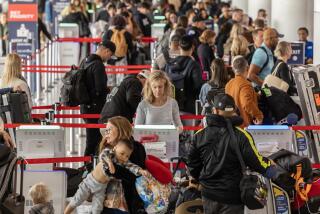Factory Growth Continues
- Share via
U.S. manufacturing expanded briskly for a 13th straight month in June and construction spending cooled a bit in May, according to two reports Thursday showing that the economy’s robust expansion is on track.
The Institute for Supply Management said its June survey of factory activity edged down to 61.1 from May’s 62.8 level but still reflected hearty growth in a sector that makes up less than a fifth of the economy. A reading above 50 signals expansion.
High readings in new orders and production and another solid month of hiring showed that strong growth was helping manufacturers heal the wounds of the sharp downturn that led to about 3 million job losses.
In a hopeful sign for inflation, the price index also eased down further from its nearly 25-year peak hit two months earlier, falling to 81.0 in June from 86.0 a month earlier. In recent weeks oil and gasoline prices have come down from their record peaks, though they remain relatively high.
That should provide some relief to Federal Reserve policymakers, who hiked official rates for the first time in four years Wednesday but also played down the jump in price pressures this year, saying it was mostly due to “transitory factors” such as commodity prices.
Rising interest rates may be starting to take a bite out of the housing market and construction spending, which rose just 0.3% in May to a seasonally adjusted $988.53-billion annual rate, below forecasts for a 0.7% rise.
The Fed began tightening its loose monetary policy by taking its federal funds rate on overnight bank lending to 1.25% from a 46-year low of 1%, and said it planned to keep lifting rates at a “measured” pace, barring any further run-up in inflation.
Norbert Ore, head of the ISM manufacturing survey committee, said he expected price pressures to ease in the second half of the year because factories have already adapted to most of the shock from higher energy costs.
“I think the major increases that needed to take place have been put in place and now we’re seeing things start to behave more normally where supply and demand are in better balance and prices are more negotiable,” he said.
The jobs picture continued to be bright, with the ISM employment index slipping to 59.7 from a 31-year high in May of 61.9.
A third report Thursday showed first-time claims for jobless benefits edged up to 351,000 in the week ended June 19 from 350,000 the prior week.
More to Read
Inside the business of entertainment
The Wide Shot brings you news, analysis and insights on everything from streaming wars to production — and what it all means for the future.
You may occasionally receive promotional content from the Los Angeles Times.










